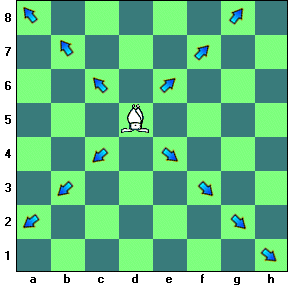|
|
 |
Chess Moves
On the
chess board, not all chess pieces behave the same. Each piece moves in a
different way.
The King
The King (denoted by K) can move only one square at a
time, horizontally, vertically or diagonally. For example, considering
an empty board, a King on e4 (written Ke4 in chess notation) may move
to e3,e5, d4, f4, d3, f3, d5, f5.
The Queen
|
The Queen (denoted by Q), like the King, can move in all
directions, namely horizontally, vertically or diagonally.
Unlike the King, however, the Queen may move
any number of squares. This increased mobility makes the Queen
the most valuable chess piece. Consequently, a Queen
located at d4 (written Qd4) may move to all 7 squares on the d
file, all 7 squares on the fourth rank, all 7 squares on the
'a1-h8' diagonal and all 6 squares on the 'b7-g1' diagonal, a total of 27 possible moves. |
 |
The Rook
| The
Rook (denoted by R) is capable of moving only along files and ranks,
any number of squares. The Rook is the next most valuable piece
after the Queen. So a Rook placed on b5 (written Rb5) may move to all 7
squares on the b file and all 7 squares on the fifth rank. |
 |
The Bishop
| The
Bishop (denoted by B) can only move along diagonals, any number of
squares. So, the Bishops are always moving on squares of the same color.
A Bishop moving on white squares is called a "light-squared bishop", as
opposed to the "dark-squared bishop", which moves on black squares. The
Bishop is about the same value as a Knight, may be slightly more. |
 |
The Knight
| The
Knight (denoted by N) has an awkward way to move. Its move forms an 'L'
in any direction, namely it moves two squares horizontally and one
vertically or vice versa. Thus, a Knight on d7 (Nd7) may move to b8, b6,
c5, e5, f6 or f8. |
 |
The Pawn
| Finally,
the Pawn (denoted by P) is moving in the simplest way, since it can only
move one square forward (ie. across the file and towards the opponent).
However, when the pawn is on its initial position, it may move two
squares forward. For example a white pawn on e3 (Pe3 or simply
e3) may only move to e4; a black pawn on e3 (Pe3 or simply e3) may only
move to e2; but a white pawn on d2 (Pd2 or simply d2) may move either to
d3 or d4. Pawns have less value in comparison to the other pieces. |
 |
Chess Piece Value
The pieces' ability to move in certain squares determines their value.
The Queen, having the maximum flexibility, is worth 9 units. The Rook,
coming next, is worth 5 units. The Bishop and the Knight both equal to 3
units, while a Pawn is only worth 1 unit. These arithmetic values
assigned to the pieces provide a general idea of the material balance on
the board. In practice, one should consider other factors too; for
example, a badly placed, pathetic Rook may be of less value than a
centralized, powerful Knight. |
|
